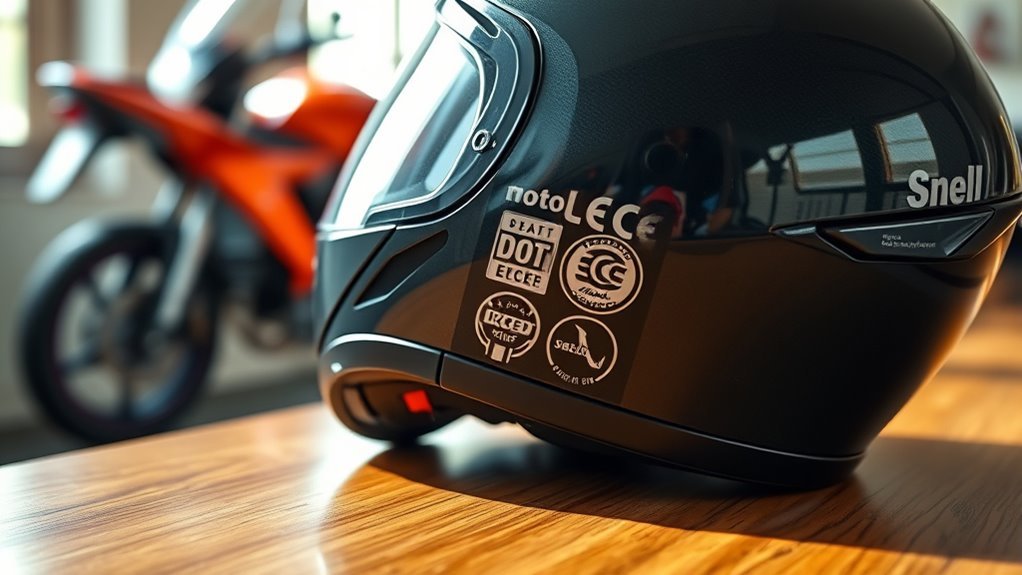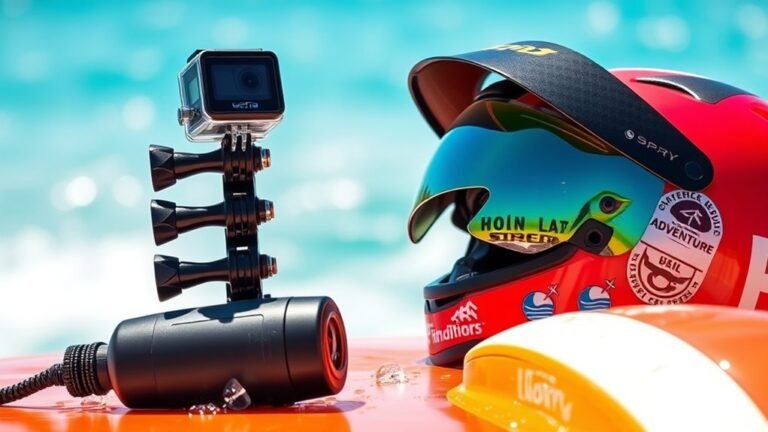Understanding DOT, ECE, and Snell Certifications for Helmets
When choosing a helmet, it’s essential to understand DOT, ECE, and Snell certifications. DOT guarantees helmets meet minimum safety standards, ECE focuses on real-world performance, and Snell emphasizes rigorous testing for high-performance protection. Each certification involves different testing procedures and safety ratings, impacting both helmet effectiveness and pricing. Not all certifications provide the same level of protection, so check specific standards carefully. By exploring these certifications, you’ll find insights for making a well-informed helmet choice.
What Is DOT Certification?
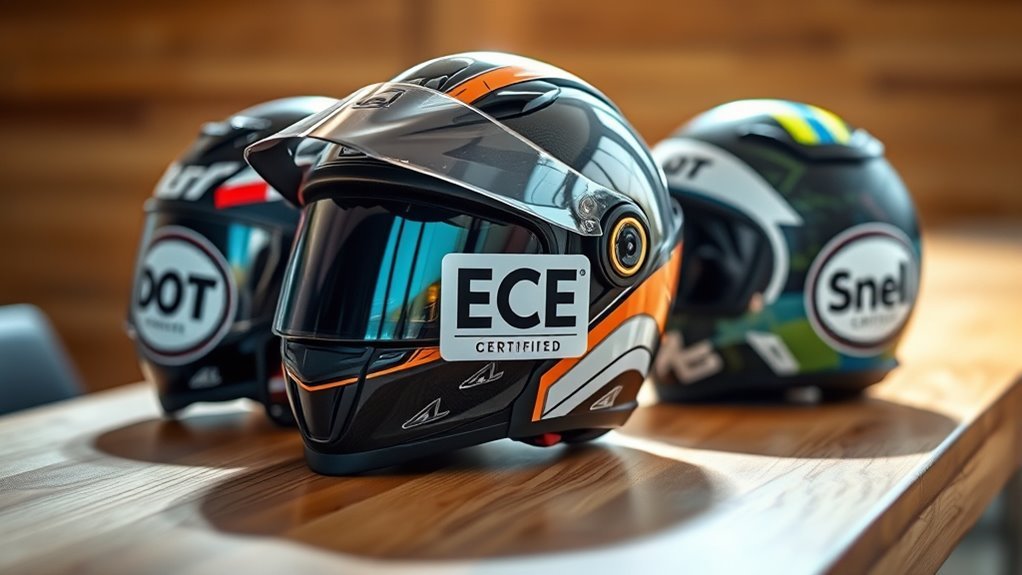
DOT certification refers to the standards set by the U.S. Department of Transportation, ensuring that helmets meet specific safety requirements for motorcyclists. To achieve DOT certification, manufacturers must rigorously test their helmets for impact resistance, penetration, and retention system effectiveness. When you choose a DOT-compliant helmet, you’re prioritizing your safety and embracing the freedom of the road with confidence. It’s essential to verify that any helmet you consider displays the DOT label, indicating it meets these stringent DOT standards. This label signifies that the helmet has undergone thorough testing and is designed to provide ideal protection in the event of an accident. Remember, your choice in helmet compliance directly impacts your safety, so always opt for certified options.
Understanding ECE Certification
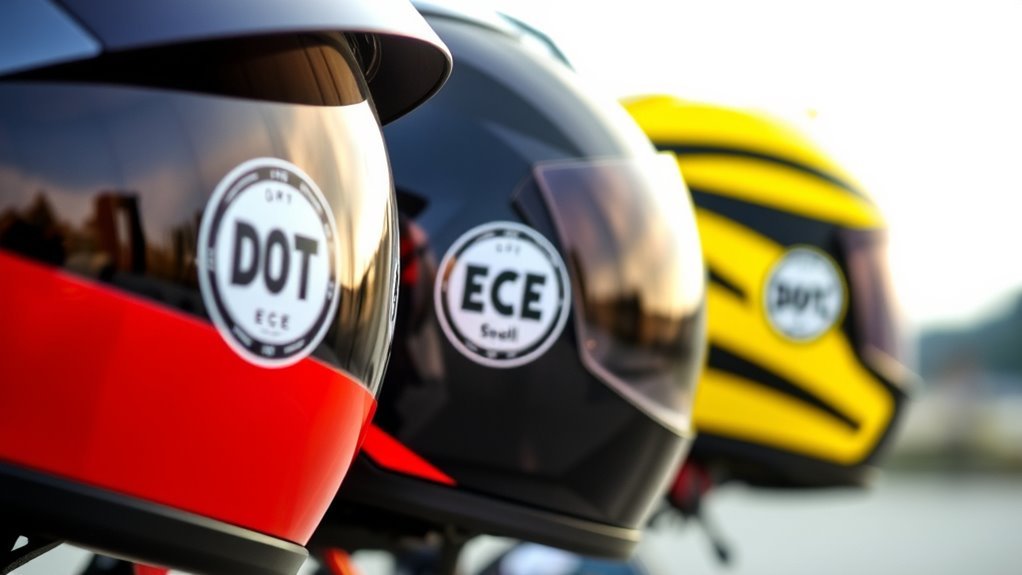
In this section, you’ll learn about ECE certification and its rigorous testing standards, which guarantee helmets meet specific safety requirements. Understanding the safety impact of ECE certification can help you make informed decisions about helmet choices that offer protection. Additionally, ECE’s global recognition highlights its importance in the helmet safety landscape.
ECE Testing Standards Explained
Although many riders may be familiar with various helmet certifications, understanding the ECE testing standards is essential for ensuring ideal safety. The Economic Commission for Europe (ECE) sets rigorous compliance requirements that helmets must meet. This certification involves a series of impact tests and inspections to verify the helmet’s effectiveness in real-world conditions.
| ECE Testing Aspects | Description |
|---|---|
| Impact Resistance | Measures how the helmet absorbs shock |
| Penetration Resistance | Tests the helmet’s ability to withstand sharp objects |
| Retention System Strength | Evaluates the effectiveness of straps and retention mechanism |
Safety Impact of ECE
Understanding the safety impact of ECE certification is essential for anyone serious about rider protection. ECE safety standards guarantee that helmets undergo rigorous testing, focusing on both impact resistance and durability. These tests simulate real-world crash scenarios, evaluating how well a helmet can absorb energy and protect your head. When you choose an ECE-certified helmet, you’re guaranteeing peak helmet performance in potentially life-threatening situations.
Moreover, ECE certification encompasses various sizes and weights, guaranteeing that helmets provide a secure fit, which is critical for maintaining safety during rides. By prioritizing helmets that meet these standards, you’re not just enhancing your safety; you’re embracing the freedom of the open road with confidence, knowing you’re protected by a quality-tested helmet.
Global Recognition of ECE
Recognized globally, ECE certification serves as a benchmark for helmet safety across many countries, ensuring that riders receive consistent protection standards. This certification aligns with international helmet regulations, promoting uniformity in safety across diverse markets. When you choose an ECE-certified helmet, you’re opting for a product tested against rigorous global helmet standards, providing assurance that it meets essential safety criteria. Many countries, especially in Europe, mandate ECE certification for helmets, making it vital for both manufacturers and consumers. By understanding these standards, you empower yourself to make informed decisions that prioritize your safety and freedom on the road. Ultimately, embracing ECE certification means trusting a globally recognized symbol of quality and protection.
The Importance of Snell Certification
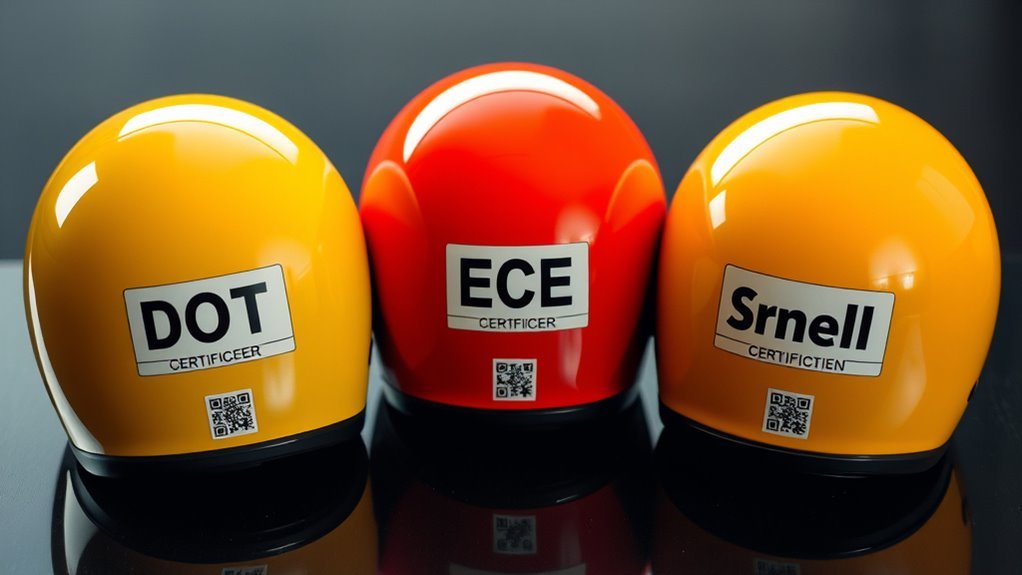
When choosing a helmet, it’s essential to evaluate Snell certification, as it signifies that the helmet has undergone rigorous testing for impact resistance and safety performance. Founded in 1957, Snell Memorial Foundation has a rich history of promoting helmet safety. Understanding the certification process helps you make informed decisions. Here are three reasons why Snell certification matters:
- Enhanced Safety: Snell-certified helmets exceed minimum safety standards, offering better protection in high-impact scenarios.
- Consistent Testing: The certification process involves repeated testing, ensuring helmets maintain high-performance levels across various conditions.
- Industry Recognition: Many racing organizations and motorcycling communities require Snell certification, reflecting its importance in professional safety standards.
Opting for a Snell-certified helmet gives you peace of mind on the road or track.
Testing Procedures for Each Certification
Helmet certifications vary considerably in their testing procedures, which ultimately affect safety performance. The DOT certification employs specific impact and penetration testing methods, guaranteeing helmets withstand real-world accidents. ECE testing involves a broader range of impact scenarios, focusing on both energy absorption and retention. Meanwhile, Snell certifications push the envelope further, requiring helmets to meet rigorous certification criteria that exceed federal standards, often involving multiple impact tests at different velocities. Each certification’s testing methods reflect its philosophy on safety, with Snell emphasizing high-performance standards. Understanding these procedures helps you choose a helmet that aligns with your safety needs while enjoying the freedom of the ride. Always check for the appropriate certification to guarantee maximum protection.
Key Differences Between DOT, ECE, and Snell
While each certification serves the primary purpose of guaranteeing rider safety, the key differences between DOT, ECE, and Snell certifications lie in their testing standards and performance criteria. Understanding these distinctions is essential for achieving the best helmet safety. Here’s a breakdown:
Each helmet certification—DOT, ECE, and Snell—has unique testing standards vital for ensuring optimal rider safety.
- DOT: Primarily US-focused, it tests for impact and penetration resistance but lacks extensive performance evaluation.
- ECE: European standard that emphasizes a balance of impact resistance and field tests, guaranteeing real-world performance.
- Snell: A voluntary, rigorous standard that demands helmets undergo multiple impact tests, focusing on high-performance criteria.
When choosing a helmet, consider these certification standards to guarantee you’re getting the protection you need on the open road.
How to Choose the Right Helmet for Your Needs
Choosing the right helmet starts with determining the specific activity you’ll be engaging in, as different sports require different designs and features. Next, it’s essential to take into account fit and comfort, making sure the helmet sits securely without causing discomfort. Finally, evaluate safety ratings to verify the helmet meets the necessary standards for maximum protection.
Determine Your Activity Type
How do you determine the right helmet for your specific activity? First, consider the demands of your activity and the type of helmet usage it requires. Different sports and environments necessitate different levels of protection. Here are three key factors to evaluate:
- Activity Type: Are you riding a motorcycle, mountain biking, or participating in snow sports? Each activity has specific safety standards.
- Impact Level: Assess the potential impact risks associated with your activity. Higher speeds or rough terrains require more robust helmets.
- Environmental Conditions: Consider factors like weather, terrain, and visibility, as these can affect the helmet’s design and materials.
Consider Fit and Comfort
Finding the right fit and comfort in a helmet is vital for guaranteeing safety and enhancing your experience during any activity. Start by focusing on helmet sizing; it’s important to measure your head accurately to find the right size. A well-fitted helmet should sit snugly but not overly tight, preventing any movement during use. Next, consider the comfort materials used in the helmet’s interior. Look for helmets with moisture-wicking liners and padding that contours to your head, as these features enhance comfort during long rides. Additionally, adjustable vents can improve airflow, preventing overheating. Ultimately, investing time in finding the right fit and comfort guarantees you’ll enjoy your adventures while staying protected.
Evaluate Safety Ratings
While the fit and comfort of a helmet are vital, evaluating safety ratings is equally important in selecting the right helmet for your needs. Understanding helmet safety ratings will help you make an informed choice. Here are three key factors to take into account:
- Certification Importance: Look for helmets with DOT, ECE, or Snell certifications, as these indicate compliance with rigorous safety standards.
- Impact Resistance: Check the helmet’s ability to withstand impact forces, which is essential for minimizing injury during accidents.
- Retention System: Verify the helmet features a reliable retention system, such as a chin strap, to keep it securely in place during a ride.
The Impact of Certification on Helmet Pricing
When you consider purchasing a helmet, the certification it carries greatly influences its price. Certifications like DOT, ECE, and Snell involve rigorous testing standards, which often lead to higher production costs. This means helmets with these certifications typically command higher prices due to the enhanced safety features and reliability they offer. In a certification value comparison, you’ll find that while lower-priced helmets may meet basic safety standards, they often lack the thorough testing that certified models undergo. As a result, when evaluating helmet pricing factors, it’s essential to weigh the benefits of certified helmets against your budget. Investing in a certified helmet can considerably enhance your protection, providing peace of mind during your rides while ensuring you’re getting the value you deserve.
Common Misconceptions About Helmet Certifications
Many riders assume that all helmets with certifications provide the same level of protection, but this isn’t the case. Understanding the nuances can help you avoid common helmet myths and certification confusion. Here are three misconceptions you should know:
- All Certifications Are Equal: DOT, ECE, and Snell tests vary in their criteria and focus, leading to different performance levels in real-world scenarios.
- Higher Price Equals Better Protection: A more expensive helmet doesn’t always mean superior safety; it’s crucial to check the specific certification standards.
- Old Helmets Are Still Safe: Helmets degrade over time, and older models may not meet current safety standards, regardless of their original certification.
Stay informed, and choose wisely to guarantee you’re not compromising your safety on the road.
Frequently Asked Questions
Can Helmets With Multiple Certifications Be Better Than Single-Certified Ones?
They say, “Better safe than sorry,” and that rings true for helmets. Helmets with multiple certifications often provide significant advantages over single-certified ones. They’re tested under various conditions, ensuring better protection across different scenarios. Single certification limitations might not cover every impact type, leaving you vulnerable. By choosing a helmet with multiple certifications, you enhance your safety and freedom on the road, giving you peace of mind while riding.
How Often Should I Replace My Certified Helmet?
You should replace your certified helmet every 5 to 7 years, even if it appears undamaged. The helmet’s lifespan can be affected by factors like UV exposure, temperature, and general wear. Regularly inspect it for any signs of deterioration, such as cracks or a compromised inner lining. Prioritizing safety means understanding that materials can degrade over time, so don’t take chances with your protection. Stay safe and guarantee your helmet’s up to date for maximum freedom on the road.
Are There Specific Helmets for Different Types of Riding?
Yes, there are specific helmets for different types of riding. For road riding, you’ll want a streamlined helmet that balances aerodynamics and comfort. Off-road riding requires a more robust design, often with a visor and better ventilation. Racing helmets are engineered for high-speed performance, focusing on impact resistance and weight reduction. For casual riding, a versatile helmet that’s comfortable and stylish suits your needs best, ensuring safety without sacrificing freedom.
Do Certifications Apply to All Helmet Brands Equally?
Certifications don’t apply to all helmet brands equally. Each brand must meet specific certification criteria, which can vary. While a reputable brand might prioritize safety and quality, others may cut corners. You’ll want to choose a helmet that not only meets these standards but also boasts a strong brand reputation. Remember, your freedom on the road is only as good as the protection your helmet provides, so choose wisely and ride confidently.
Can I Trust Non-Certified Helmets?
You can’t fully trust non-certified helmets. They often lack essential helmet testing standards designed to guarantee safety. These helmets might not undergo rigorous impact and penetration tests that certified ones do, putting you at risk during a crash. While some non-certified options may appear appealing for their price or design, prioritizing your safety means choosing helmets that meet established standards. Remember, your freedom to ride should never compromise your protection.
